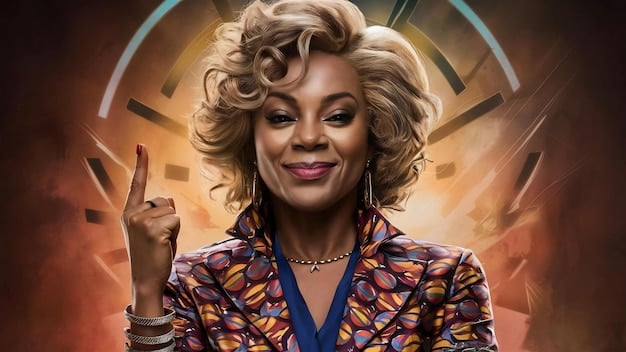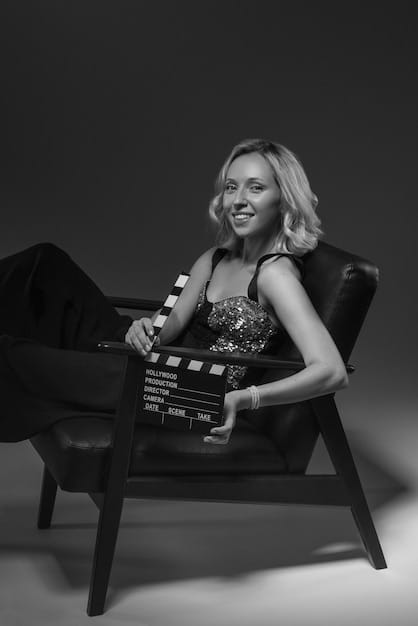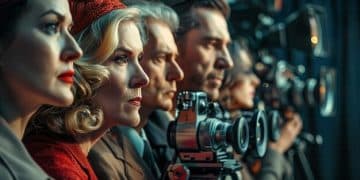The Rise of Female Directors: Hollywood’s Glass Ceiling Shattered

The rise of female directors in Hollywood signifies a monumental shift, challenging historical biases and enriching cinematic narratives with diverse perspectives, ultimately reshaping the landscape of the film industry.
Hollywood’s historical narrative has often been told through a male lens, but the 21st century is witnessing a remarkable transformation: the rise of female directors. This movement isn’t just about filling quotas; it’s about enriching cinema with fresh perspectives, untold stories, and a more accurate reflection of the world we live in.
The Historical Underrepresentation of Women in Directing
The film industry, for decades, has been notoriously skewed in favor of male directors. Gaining insights into why this disparity has existed for so long is important to give context for the current shift happening for female directors.
Before the rise of female directors, women were often relegated to supporting roles, both on-screen and behind the camera. The historical underrepresentation of women in directing is not merely a matter of numbers but reflects deeper systemic issues within the industry, related to funding, stereotypes and recognition.
Stereotypes and Bias
- Female directors in decades past were commonly perceived as less capable of handling large-scale productions or action-oriented films.
- There also existed bias in genres, where female directors were deemed more suitable for romantic comedies or dramas, limiting their opportunities in other areas.
- The perception was not just limited to external stakeholders; even within creative teams, women had to work harder to prove their vision and gain the respect of their peers, leading to a more difficult and less inspiring path into directing.
Funding and Opportunities
- The distribution of grants and investment opportunities were often skewed against female directors, placing female directors at a considerable disadvantage.
- Financial backers have historically been more inclined to invest in male-led projects, citing concerns about risk and return on investment.
- This lack of financial support created a cycle in which female directors struggled to gain experience with high-budget productions, further reinforcing the aforementioned stereotypes.
Despite the challenges, women persisted. Many talented female directors have been breaking these barriers and gaining greater acclaim and recognition over the last decade.

Pioneering Female Directors Who Paved the Way
Before the current wave of recognition, several pioneering female directors laid the groundwork, battling sexism and industry norms to create lasting works of art. They stand as role models and inspirations for the generations of women who followed.
Though many talented female directors were creating cinema in the past, they were often overlooked due to the male domination of the industry. It’s important to recognize the contributions made by the female directors in years past to see how much the tides have turned, and how much more ground that needs to be gained.
Dorothy Arzner
Dorothy Arzner was a trailblazer in the early days of Hollywood, she defied gender expectations to become one of the first and most successful female directors. She started her career as a script girl and editor, eventually transitioning into directing in the 1920s. Arzner directed numerous films, working with stars like Katharine Hepburn and Lucille Ball, but has been relatively forgotten by popular culture.
Ida Lupino
Ida Lupino was an actress-turned-director who made significant contributions to both film and television. In the 1950s, she directed several films that tackled socially relevant and controversial issues, such as unwanted pregnancy and sexual assault. Lupino’s work earned her critical acclaim and recognition as a progressive filmmaker that pushed boundaries for women in the industry.
Today, the success of contemporary female directors such as Patty Jenkins, Ava DuVernay, and Greta Gerwig, can be partially attributed to these pioneering women, who proved that women could excel behind the camera.
Contemporary Female Directors Making Waves
The 21st century has witnessed the rise of numerous talented female directors who are redefining the cinematic landscape. These women are not only making commercially successful films but also using their platforms to tell diverse stories and challenge traditional narratives.
With the critical and commercial success of numerous movies directed by women, female directors have been gaining momentum in the film industry. This is due to awareness, more funding and a change in overall mindset when it comes to female directors telling stories about various subjects, not just “female-centered stories”.
Greta Gerwig
Greta Gerwig is known for her work in both acting and directing, Gerwig has quickly become one of the most prominent voices in contemporary cinema. Best known for indie films like “Frances Ha” and “Lady Bird,” she garnered widespread acclaim for her adaptation of “Little Women.” Gerwig’s films are notable for their sharp writing, nuanced character development, and exploration of female identity. Now, she continues to prove time and time again that female-directed films are nothing to take lightly. Barbie was one of the biggest films of 2023, if not the biggest.
Ava DuVernay
Ava DuVernay is a director, producer, and distributor, DuVernay has dedicated her career to amplifying the voices of marginalized communities. DuVernay’s work includes documentaries that deal with racial inequality in the United States, proving her versatility as a director. She continues advocating for diversity and inclusion in Hollywood, helping to pave the way for other filmmakers of color.

Many other amazing female directors exist, and hopefully even more will gain attention in the near future. As more and more female directors are given the opportunity to share their creative voices, the more compelling cinema will be.
The Impact on Representation and Storytelling
The increased presence of female directors has had a profound impact on representation and storytelling within the film industry.
Representation matters now more than ever, with many demanding inclusivity and representation in media. Female directors are in a rare position to change the scope and message of a film from behind the camera.
Diverse Perspectives
- Female directors bring diverse perspectives and experiences to their work, leading to more nuanced and authentic storytelling.
- They tackle complex issues such as gender identity, relationships, and social justice, challenging stereotypes and promoting empathy.
- This shift allows for stories that reflect the lives and experiences of women from diverse backgrounds, providing audiences with fresh and previously unheard narratives.
Empowering Female Characters
- Female directors often create more complex and empowering female characters, moving away from the traditional damsel-in-distress archetype.
- They explore the inner lives and struggles of women, giving them agency and depth within the narrative.
- It also allows movies to challenge the male gaze that has dominated cinema for so long, empowering women and their stories even more.
By embracing diverse voices and inclusive storytelling, cinema becomes more reflective of the world and more meaningful to audiences. It enhances inclusivity, promotes empathy, and moves beyond the singular male-dominated narrative.
Challenges and Obstacles Still Faced for Female Directors
Although significant progress has been made, female directors still face numerous challenges and obstacles in the industry.
While progress has been made for female directors in the film industry, there are still considerable issues that persist. The more these challenges are addressed, the greater the potential rise and increased impact will be for women in film..
Gender Bias
Despite growing awareness, gender bias still exists in various aspects of filmmaking. Female directors often have to work harder to be taken seriously and prove their capabilities. Overcoming this bias requires ongoing advocacy, education, and systemic changes within the industry.
Access to Resources
Female directors still face challenges in accessing funding, distribution channels, and influential networks. Financial backers and distributors may be hesitant to invest in female-led projects, citing concerns about marketability and audience appeal. This lack of support creates an uneven playing field and limits opportunities for female directors to create and showcase their work.
Working together to create an inclusive film industry where gender is not a barrier to success is an important and worthy calling for the future of cinema.
The Future of Female Directors in Hollywood
The future of female directors in Hollywood is filled with possibilities and potential. As the industry continues to evolve, there is growing recognition that diverse voices and inclusive storytelling are essential for creating resonant and relevant movies.
The landscape of the film industry has shifted, but there is still plenty of opportunity for growth when it comes to showcasing women in the director’s chair. The movement of the growth of female directors is showing no signs of slowing down.
Mentorship Programs
- Continued support for mentorship programs and initiatives that provide aspiring female directors with guidance, training, and networking opportunities.
- Mentorship is an effective way to inspire and empower upcoming filmmakers, fostering a more inclusive and collaborative environment.
Investment in Female-Led Projects
- A shift in mindset among financial backers and distributors, with a greater willingness to invest in female-led projects and champion diverse storytelling.
- This commitment will allow more female directors to bring their visions to life and reach wider audiences.
The rise of female directors in Hollywood represents a profound shift towards inclusivity, diversity, and authentic storytelling, promising a richer and more meaningful cinematic landscape for generations to come.
| Key Factor | Brief Insight |
|---|---|
| 🎬 Historical Bias | Women faced underrepresentation due to stereotypes and limited funding. |
| 🌟 Pioneering Directors | Dorothy Arzner and Ida Lupino paved the way, breaking industry norms. |
| 🏆 Contemporary Success | Greta Gerwig and Ava DuVernay are redefining the cinematic landscape. |
| 🌍 Impact on Storytelling | Diverse perspectives lead to more authentic and empowering narratives. |
Ask Questions
▼
Female directors often faced gender bias, stereotypes, and limited access to funding and resources, especially compared to their male counterparts, making it difficult to rise in the industry.
▼
Dorothy Arzner and Ida Lupino are considered pioneering female directors. They defied gender expectations, made great films, were able to rise to a prominent directorial position.
▼
Female directors bring diverse perspectives, creating more nuanced and authentic stories. They create complex characters, exploring issues that have been typically ignored for a more empathetic cinema.
▼
Gender biases, limited access to resources, and challenges in securing funding and distribution. Ongoing efforts, education, and systemic changes, are needed to have greater inclusivity.
▼
The film industry can support the future of female directors by investing in mentorship programs that empower female filmmakers, thus creating a more supportive environment. Continued support will further diversify storytelling.
Conclusion
The journey of women in Hollywood’s directing landscape is a testament to resilience, talent, and the relentless pursuit of equality. While challenges persist, the rising tide of female voices is reshaping the cinema, offering richer, more authentic stories that resonate with global audiences. As the industry continues to evolve, ensuring diverse perspectives behind the camera is not just a matter of fairness; it’s essential for the art of filmmaking itself.





